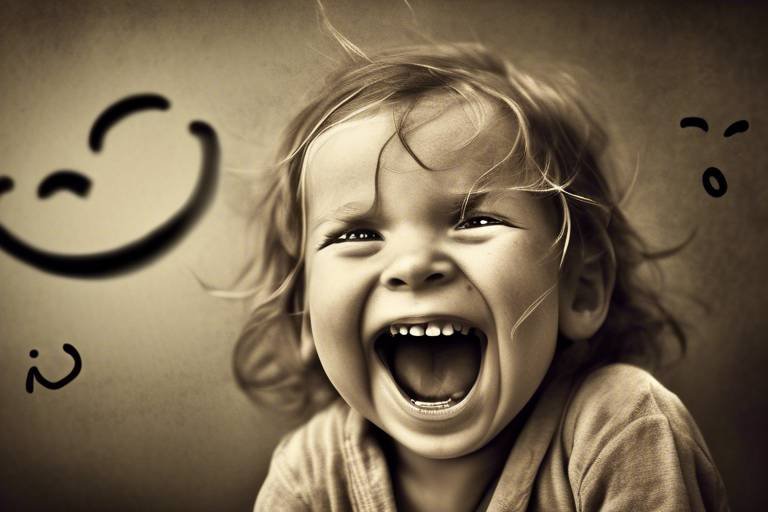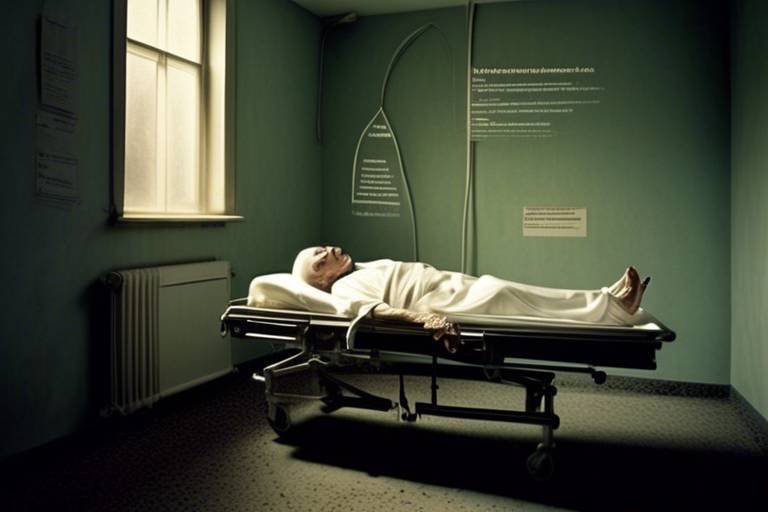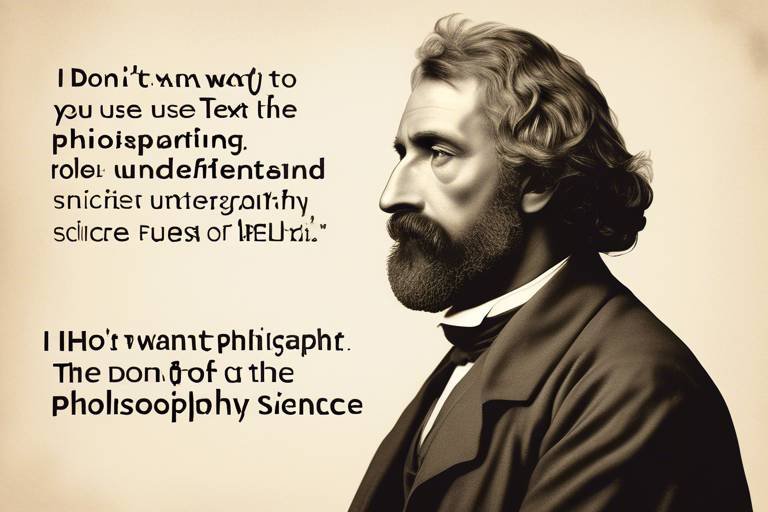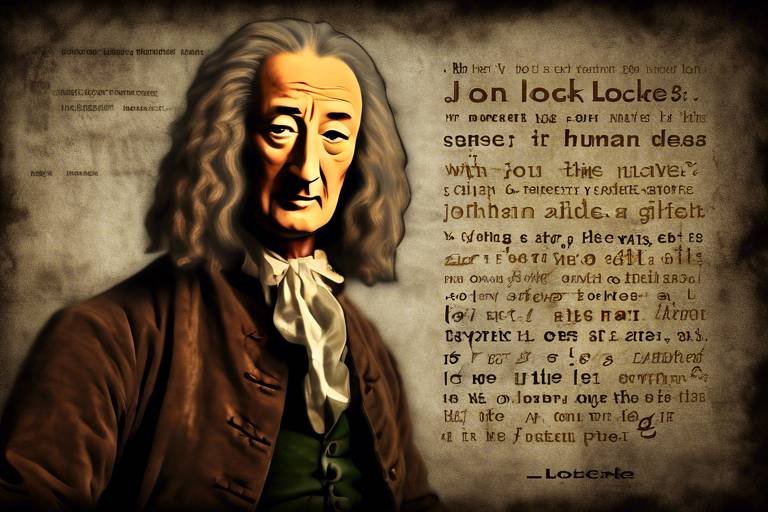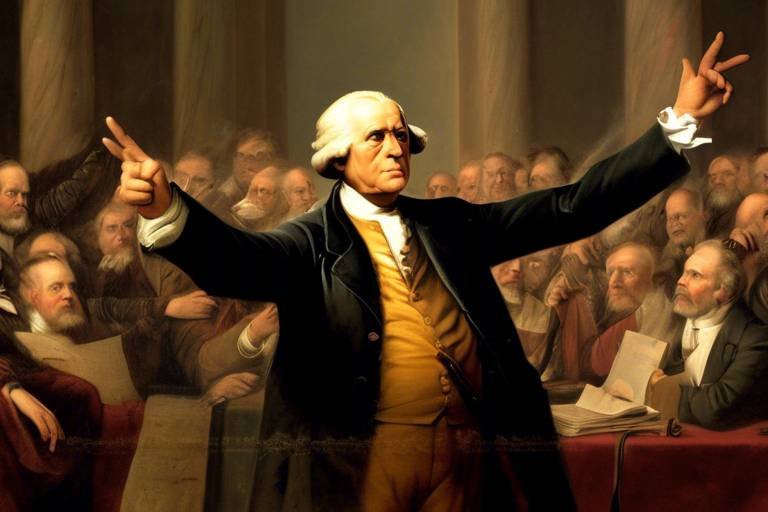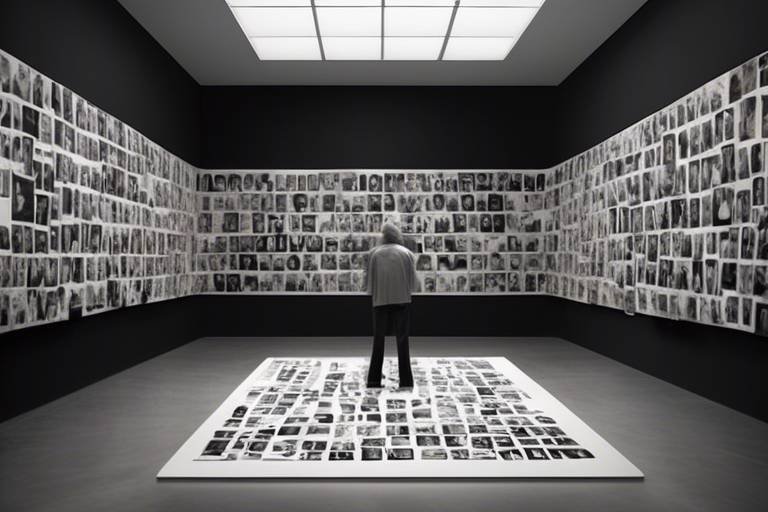Interpretation of Freud's Psychoanalytic Theory: A Philosophical Angle
Freud's psychoanalytic theory has long been a cornerstone in the realms of psychology and philosophy, igniting debates and discussions that traverse the boundaries of both disciplines. At its core, this theory delves deeply into the complexities of the human mind, suggesting that much of our behavior is influenced by unconscious processes that we may not even be aware of. Imagine trying to navigate a vast ocean, where the surface appears calm, but beneath lies a swirling tempest of emotions, desires, and fears. This metaphor captures the essence of Freud's view on the unconscious—it's a hidden world that shapes our realities in profound ways.
As we explore the philosophical implications of Freud's work, we find ourselves grappling with questions about the nature of self, free will, and the very essence of human existence. How much control do we truly have over our actions if our unconscious mind is pulling the strings? This inquiry leads us into a fascinating dialogue between psychoanalysis and existential philosophy, where the struggle for self-understanding becomes paramount. Freud's insights compel us to confront uncomfortable truths about our motivations, often revealing that the desires we acknowledge are just the tip of the iceberg.
Moreover, the interplay between psychology and philosophy in Freud's work is not merely academic; it has practical implications for how we approach mental health today. The therapeutic techniques derived from his theories, such as talk therapy, have paved the way for modern psychological practices. These methods encourage individuals to explore their unconscious thoughts and feelings, fostering a deeper understanding of themselves. In essence, Freud's psychoanalytic theory serves as a bridge, connecting the intricate workings of the mind with broader philosophical questions about the human condition.
In this article, we will dive deeper into Freud's concepts, the critiques that have emerged over the years, and the enduring relevance of his ideas in contemporary thought. We'll examine how Freud's notions of the unconscious and dream interpretation reveal the hidden layers of our psyche, and how these insights continue to resonate in today's discussions about mental health and personal identity. So, are you ready to embark on this intellectual journey? Let's uncover the layers of Freud's theory and see what philosophical treasures lie beneath!

Understanding the Unconscious
When we think about our minds, it’s easy to imagine a clear, well-lit room filled with thoughts and ideas that we can easily access. However, Freud's concept of the unconscious suggests that much of what drives our behavior is hidden away in the shadows. It’s like an iceberg, where only a small portion is visible above the surface, while the majority lurks beneath, influencing our actions and decisions without us even realizing it. This hidden part of our psyche is believed to contain our repressed memories, desires, and emotions—elements that can profoundly shape our thoughts and behaviors.
Freud posited that the unconscious mind is a reservoir of feelings, thoughts, urges, and memories that are outside of our conscious awareness. Imagine trying to navigate a ship through fog; you may be aware of the immediate surroundings, but there are unseen rocks and currents that can steer you off course. Similarly, our unconscious can lead us to react in ways that seem irrational or out of character, often rooted in unresolved conflicts or suppressed feelings. This idea raises intriguing questions: How much of our daily behavior is dictated by these hidden forces? Are we truly in control of our actions, or are we merely puppets of our unconscious mind?
One of the most significant implications of understanding the unconscious is its role in human behavior. Freud believed that our unconscious mind affects our relationships, motivations, and even our physical health. For instance, consider the phenomenon of Freudian slips, where a person accidentally says something that reveals their true feelings or desires. These slips are not mere accidents; they are windows into the unconscious, showcasing how deeply embedded our hidden thoughts can be. The unconscious can also manifest through dreams, as we will explore later, serving as a bridge between our waking life and the hidden layers of our psyche.
Moreover, the unconscious is not just a dark void; it is a dynamic and active part of our mental processes. It can influence our decision-making in subtle ways, often leading us toward choices that align with our unacknowledged desires or fears. For example, a person might feel an inexplicable attraction to a particular career path, driven by a passion they aren’t consciously aware of. This interplay between the unconscious and conscious mind highlights the complexity of human behavior and invites us to explore the intricate tapestry of our thoughts and feelings.
Understanding the unconscious also opens up avenues for self-discovery. By engaging with our unconscious mind, we can uncover hidden aspects of ourselves, leading to greater self-awareness and personal growth. Techniques such as free association, where individuals express their thoughts without censorship, can help bring unconscious material to the surface. This process can be likened to digging for treasure; while the digging may be uncomfortable, the discoveries can be profoundly rewarding. By confronting what lies beneath, we can better understand our motivations and the roots of our behavior.
In summary, Freud's exploration of the unconscious offers a fascinating glimpse into the hidden depths of our minds. It challenges us to consider that our thoughts and actions may not always be as straightforward as they seem. As we delve deeper into Freud's theories, it becomes evident that understanding our unconscious is not just an academic exercise; it is a journey toward greater self-awareness and emotional health.

The Role of Dreams
When we think about dreams, it’s easy to dismiss them as mere nighttime narratives that evaporate upon waking. However, Sigmund Freud viewed dreams as the royal road to the unconscious, a vital pathway that reveals our innermost thoughts, desires, and conflicts. According to Freud, dreams are not just random images; they are laden with meaning and significance, serving as a window into our repressed emotions and unresolved issues. This perspective invites us to reconsider the purpose of dreaming: could it be that our subconscious is trying to communicate something crucial to our waking lives?
Freud argued that dreams are a form of wish fulfillment, a way for the mind to express desires that society and morality often suppress. For instance, if you dream about flying, it might symbolize a desire for freedom or escape from the constraints of daily life. On the other hand, dreaming of being chased could reflect anxiety or avoidance of a particular situation in your life. The beauty of dream analysis lies in its ability to unveil these hidden meanings, connecting the dots between our conscious experiences and our unconscious motivations.
To truly grasp the role of dreams in Freud's psychoanalytic theory, one must understand the various techniques he developed for analyzing them. Freud introduced methods such as free association, where patients articulate their thoughts without censorship, allowing the unfiltered expression of their subconscious. This technique can often lead to surprising insights, revealing how deeply intertwined our dreams are with our waking thoughts and feelings.
Freud’s approach to dream analysis was groundbreaking. He believed that understanding dreams required not only a careful examination of their content but also an appreciation of the symbols within them. For instance, a dream about a snake could represent repressed sexual desires or fears. By interpreting these symbols, one can uncover the underlying psychological conflicts at play.
Freud also emphasized the importance of the dreamer's personal context. A symbol in one person's dream may carry a vastly different meaning for another, depending on their unique experiences and emotional landscape. This subjectivity is what makes dream analysis both an art and a science, as it requires a deep understanding of the individual’s psyche.
Freud identified several common symbols that frequently appear in dreams, each with its own potential meanings. Here are a few:
- Water: Often symbolizes emotions and the unconscious.
- Falling: Can indicate feelings of insecurity or loss of control.
- Teeth falling out: May represent anxiety about appearance or aging.
- Being chased: Often reflects avoidance of a difficult situation or fear.
Understanding these symbols can provide valuable insights into our psychological state, helping us navigate the complexities of our emotions and experiences.
Throughout his career, Freud documented numerous case studies that highlighted the practical application of his dream analysis techniques. One notable example is the case of a patient who frequently dreamed of being lost in a maze. Through analysis, it was revealed that this dream mirrored her feelings of confusion and entrapment in her personal life, particularly in her relationships. By addressing the underlying issues that the dream illuminated, she was able to make significant progress in her therapy.
These case studies not only illustrate the effectiveness of Freud's theories but also emphasize the importance of dreams in understanding the human psyche. They remind us that our dreams are not just fleeting images, but rather profound reflections of our inner lives that deserve our attention and exploration.

royal road to the unconscious,
This article explores the philosophical implications of Freud's psychoanalytic theory, examining its concepts, critiques, and relevance in contemporary thought, while delving into the interplay between psychology and philosophy.
An exploration of Freud's concept of the unconscious mind, its significance in human behavior, and how it shapes our thoughts, feelings, and actions beyond our conscious awareness.
This section discusses Freud's interpretation of dreams as the royal road to the unconscious, highlighting their symbolic meanings and their importance in understanding repressed desires and conflicts.
An overview of the methods Freud developed for analyzing dreams, including free association and symbolic interpretation, and how these techniques can reveal hidden aspects of the psyche.
A look at frequently encountered symbols in dreams according to Freud, exploring their meanings and how they relate to personal experiences and unconscious desires.
Examples of famous case studies where dream analysis was pivotal in understanding the patient's psyche, showcasing the practical application of Freud's theories.
An examination of the various defense mechanisms identified by Freud, such as repression and projection, and their roles in protecting the ego from anxiety and internal conflict.
This section addresses the major criticisms of Freud's psychoanalytic theory, including its scientific validity, cultural biases, and the evolution of psychological thought since his time.
An analysis of how feminist theorists have critiqued and reinterpreted Freud's ideas, particularly concerning gender roles, sexuality, and the concept of femininity.
A discussion on the ongoing influence of Freud's psychoanalytic theory in modern psychology and philosophy, examining its integration into current therapeutic practices and philosophical debates.
Freud famously dubbed dreams the royal road to the unconscious, suggesting that they offer a unique glimpse into the hidden layers of our psyche. Just like a treasure map leading to hidden riches, our dreams can reveal the buried emotions, desires, and conflicts we often ignore in our waking lives. But why are dreams so significant? They serve as a bridge between our conscious thoughts and the deeper, often troubling, aspects of our unconscious mind.
In Freud's view, dreams are not mere random images or fanciful stories. Instead, they are laden with symbolism that reflects our innermost thoughts and feelings. For example, a dream about flying might symbolize a desire for freedom, while a dream of being chased could represent feelings of anxiety or avoidance. These symbols can be as varied as the individuals who experience them, making dream analysis a deeply personal journey.
To dive deeper into understanding dreams, Freud developed several techniques that allow individuals to uncover the meanings behind their nighttime narratives. One such technique is free association, where the dreamer verbalizes their immediate thoughts and feelings related to the dream, thus peeling back layers of meaning. This process can illuminate connections between the dream content and the dreamer's waking life, revealing underlying issues that may need to be addressed.
Moreover, Freud identified common dream symbols that frequently appear across different cultures and individuals. For instance, water often signifies emotions, while a house might represent the self. Recognizing these symbols can help individuals understand their dreams better and, ultimately, themselves. Below is a brief table of some common dream symbols according to Freud:
| Dream Symbol | Possible Meaning |
|---|---|
| Water | Emotions and the unconscious |
| Flying | Desire for freedom or escape |
| Chasing | Feelings of anxiety or avoidance |
| Houses | The self or personal identity |
Additionally, Freud's theories on dreams have been illustrated through numerous case studies, where dream analysis played a crucial role in understanding a patient’s psyche. These real-life examples demonstrate the practical application of Freud's theories and highlight how dreams can serve as a therapeutic tool in psychotherapy.
- What is the significance of dreams in Freud's theory? Dreams provide insight into the unconscious mind, revealing repressed desires and unresolved conflicts.
- How does Freud analyze dreams? Freud uses techniques like free association and symbolic interpretation to uncover the meanings behind dreams.
- Are dream symbols universal? While some symbols may have universal meanings, they can also be highly personal and vary from individual to individual.
- What are defense mechanisms? Defense mechanisms are psychological strategies used to protect the ego from anxiety and internal conflict, as identified by Freud.

highlighting their symbolic meanings and their importance in understanding repressed desires and conflicts.
This article explores the philosophical implications of Freud's psychoanalytic theory, examining its concepts, critiques, and relevance in contemporary thought, while delving into the interplay between psychology and philosophy.
An exploration of Freud's concept of the unconscious mind, its significance in human behavior, and how it shapes our thoughts, feelings, and actions beyond our conscious awareness.
Freud famously referred to dreams as the "royal road to the unconscious," indicating their profound significance in revealing the hidden layers of our psyche. Dreams serve as a window into our innermost thoughts and feelings, often surfacing repressed desires and unresolved conflicts that our waking minds may choose to ignore or suppress. By interpreting the symbolic meanings of dreams, we can gain valuable insights into our emotional states and motivations.
Freud developed various methods for analyzing dreams, including free association and symbolic interpretation. These techniques allow individuals to explore their dreams in depth, uncovering hidden aspects of their psyche that may be influencing their behavior and emotional well-being.
In the realm of dream analysis, certain symbols frequently appear, each carrying its own significance. For instance, dreams about flying may symbolize a desire for freedom or escape from constraints, while dreams of being chased can reflect feelings of anxiety or avoidance. Understanding these symbols is crucial in the process of self-discovery and can shed light on our repressed desires.
Numerous case studies illustrate the power of dream analysis in understanding the complexities of the human psyche. For example, a patient who dreams of losing their teeth may be grappling with issues of self-esteem or fear of aging. These examples showcase the practical application of Freud's theories and their relevance in therapeutic settings.
An examination of the various defense mechanisms identified by Freud, such as repression and projection, and their roles in protecting the ego from anxiety and internal conflict.
This section addresses the major criticisms of Freud's psychoanalytic theory, including its scientific validity, cultural biases, and the evolution of psychological thought since his time.
An analysis of how feminist theorists have critiqued and reinterpreted Freud's ideas, particularly concerning gender roles, sexuality, and the concept of femininity.
A discussion on the ongoing influence of Freud's psychoanalytic theory in modern psychology and philosophy, examining its integration into current therapeutic practices and philosophical debates.
- What is the significance of dreams in Freud's theory?
Dreams are crucial in Freud's theory as they provide insight into the unconscious mind, revealing repressed desires and internal conflicts. - How do defense mechanisms work?
Defense mechanisms protect the ego from anxiety by distorting reality, helping individuals cope with emotional distress. - What are some criticisms of Freud's psychoanalytic theory?
Critics argue that Freud's theories lack scientific validity, are culturally biased, and have been largely overshadowed by modern psychological approaches.

Dream Analysis Techniques
When we dive into the world of dreams, we find ourselves in a realm where the subconscious reigns supreme. Freud, the father of psychoanalysis, developed a set of techniques that serve as our guides through this intricate landscape. His methods are not just tools; they are keys that unlock the hidden doors of our psyche. The primary techniques he employed include free association and symbolic interpretation. These methods help unravel the complex tapestry of our dreams, revealing the repressed desires and conflicts that lie beneath the surface.
Let's start with free association. This technique invites individuals to vocalize their thoughts without censorship, allowing the mind to wander freely. Imagine it like a river flowing without barriers, where every thought, no matter how trivial or absurd, is welcomed. In this process, a person might start with a dream image and then let their mind drift to whatever comes next. This can lead to surprising revelations about the dream's meaning, as connections are made between seemingly unrelated thoughts.
On the other hand, symbolic interpretation is akin to deciphering a secret code. Freud believed that dreams are filled with symbols that represent deeper meanings. For instance, a dream about flying might symbolize a desire for freedom or escape from reality. To decode these symbols, one must consider personal experiences and emotions. It’s like being a detective in your own mind, piecing together clues to form a coherent narrative about what your dreams are trying to convey.
To further illustrate these techniques, let's look at some common dream symbols and their interpretations:
| Dream Symbol | Possible Interpretation |
|---|---|
| Flying | Freedom, escape, or a desire to rise above challenges |
| Falling | A feeling of loss of control or insecurity |
| Being chased | Running away from fears or unresolved issues |
| Water | Emotions, the unconscious mind, or a significant life change |
In addition to these techniques, Freud's approach often included analyzing the context of the dream. The circumstances surrounding a dream can provide crucial insights. For example, if someone dreams of being late for an important event, it might reflect anxiety about their waking life responsibilities. By examining these elements, individuals can gain a clearer understanding of their emotional states and underlying issues.
Ultimately, Freud's dream analysis techniques offer a fascinating glimpse into the human psyche. They remind us that our dreams are not just random images but are deeply intertwined with our thoughts, feelings, and experiences. By engaging with these techniques, we can embark on a journey of self-discovery, uncovering the layers of our unconscious mind.
- What is free association in dream analysis? Free association is a technique where individuals express their thoughts freely, allowing for unexpected connections that can reveal deeper meanings of dreams.
- How do symbols in dreams work? Symbols in dreams represent various aspects of our lives and emotions. Understanding these symbols can help individuals interpret their dreams more effectively.
- Can dream analysis really help with personal issues? Yes, engaging in dream analysis can provide valuable insights into personal issues, helping individuals address repressed feelings and conflicts.

Common Dream Symbols
Dreams are like a treasure chest of hidden meanings, and understanding the common symbols within them can unlock insights into our innermost thoughts and desires. Freud believed that dreams are a direct pathway to the unconscious, where repressed feelings and conflicts reside. Each symbol carries its own weight and can vary in meaning depending on the context of the dream and the dreamer's personal experiences. For instance, dreaming of water often symbolizes emotions and the subconscious. Is it calm or turbulent? The state of the water can indicate how the dreamer feels about their emotional state.
Another prevalent symbol is flying. Have you ever had that exhilarating feeling of soaring through the skies? Freud interpreted flying as a representation of freedom and the desire to escape from life's burdens. Conversely, if you dream of falling, it might signify feelings of insecurity or a loss of control in your waking life. These symbols are not just random; they reflect the complex interplay of our experiences, fears, and aspirations.
To further illustrate the significance of common dream symbols, let's take a look at some frequently encountered ones:
| Symbol | Meaning |
|---|---|
| Water | Emotions, subconscious feelings |
| Flying | Freedom, escape from burdens |
| Falling | Insecurity, loss of control |
| Teeth | Fear of aging, loss of power |
| Chase | Running away from fears or unresolved issues |
Each of these symbols can reveal something profound about our psyche. For instance, dreaming about teeth falling out can evoke feelings of anxiety regarding aging or loss of power. It’s fascinating how our subconscious mind uses such vivid imagery to communicate with us. By analyzing these symbols, we can begin to peel back the layers of our unconscious mind, revealing the deeper issues that may be affecting our daily lives.
In essence, understanding common dream symbols is like having a conversation with ourselves. It’s an opportunity to reflect on our emotions, confront our fears, and gain clarity on our desires. So the next time you wake up from a dream, take a moment to ponder the symbols and what they might be trying to tell you. After all, our dreams are not just a figment of our imagination; they are a window into our soul.
- What do dreams about flying mean?
Flying often symbolizes freedom and the desire to escape from life's burdens. - Why do we dream about falling?
Falling can signify feelings of insecurity or a loss of control in one's life. - How can I remember my dreams better?
Keeping a dream journal by your bedside can help you jot down your dreams as soon as you wake up, improving recall. - Are dreams always symbolic?
While many dreams contain symbolic meanings, some may simply reflect daily experiences or concerns.

Case Studies in Dream Interpretation
Freud's theories on dream interpretation have been put to the test through various case studies that unveil the complexities of the human psyche. One of the most notable examples is the case of Anna O., a patient whose dreams revealed deep-seated traumas and repressed emotions. Her dreams were filled with images of illness and death, which Freud interpreted as manifestations of her anxiety and unresolved conflicts surrounding her father’s illness. This case not only highlighted the importance of dream analysis but also set the stage for the development of psychoanalytic therapy as a whole.
Another fascinating case is that of Little Hans, a young boy who developed a phobia of horses. Through dream analysis, Freud discovered that Hans's fear was tied to his complicated feelings towards his parents, particularly his father. In his dreams, horses symbolized his father’s authority and the anxiety associated with it. By interpreting these dreams, Freud was able to guide Hans's parents in addressing his fears, demonstrating how dreams can serve as a valuable tool in understanding familial relationships and childhood development.
Freud also analyzed the dreams of patients like Irma, whose dream of being poisoned led to a profound exploration of her feelings of guilt and inadequacy. In this case, the dream acted as a gateway to understanding her repressed feelings regarding her health and relationships. Freud’s method of free association allowed Irma to articulate her fears, revealing hidden conflicts that were affecting her well-being. This case exemplifies how dreams can act as mirrors reflecting our inner struggles, making them crucial in therapeutic settings.
These case studies illustrate the practical application of Freud's dream analysis techniques, showing how they can uncover layers of meaning that might otherwise remain hidden. By exploring the symbolic meanings behind dreams, therapists can gain insights into their patients' unconscious desires and conflicts. The significance of these interpretations lies not only in the therapeutic context but also in how they contribute to our understanding of human behavior as a whole.
In conclusion, the case studies surrounding Freud’s dream interpretation reveal the profound impact that dreams can have on our understanding of the self. They serve as a reminder that our unconscious mind often communicates through symbols and narratives, offering a rich tapestry of insights waiting to be explored. As we delve deeper into our dreams, we may uncover the very threads that weave together our experiences, fears, and desires, ultimately guiding us toward a greater understanding of ourselves.
- What is the significance of dream analysis in psychoanalysis?
Dream analysis is significant as it provides insight into the unconscious mind, revealing repressed emotions and desires that influence behavior. - How did Freud develop his dream interpretation techniques?
Freud developed his techniques through clinical observations and case studies, emphasizing the importance of free association and symbolism in understanding dreams. - Are Freud's interpretations of dreams still relevant today?
While some aspects of Freud's theories have been critiqued, many contemporary psychologists still find value in dream analysis as a therapeutic tool. - Can dreams predict the future?
Freud did not believe that dreams predict the future; rather, he viewed them as reflections of our inner thoughts and conflicts.

Defense Mechanisms
Defense mechanisms are fascinating psychological strategies that our minds use to cope with anxiety and protect our self-esteem. Developed by Sigmund Freud, these mechanisms are like mental shields, helping us navigate the complexities of our emotions and experiences. When faced with stress, conflict, or uncomfortable feelings, our psyche often resorts to these subconscious tactics to maintain a sense of balance and protect the ego from overwhelming distress.
At the core of Freud's theory, defense mechanisms serve as a way for individuals to manage internal conflicts between their desires and societal expectations. One common example is repression, where painful memories or thoughts are pushed out of conscious awareness. Think of it like a beach ball: the harder you push it underwater, the more forcefully it tries to resurface. Similarly, repressed emotions may eventually demand attention, often manifesting in unexpected ways, such as anxiety or physical symptoms.
Another notable defense mechanism is projection, which involves attributing one's own undesirable feelings or thoughts onto someone else. For instance, if someone feels insecure about their abilities, they might accuse others of being incompetent. This mechanism allows individuals to avoid confronting their own flaws by externalizing them, almost as if they are casting shadows onto others rather than facing their own reflections.
Here’s a brief overview of some common defense mechanisms:
| Defense Mechanism | Description |
|---|---|
| Repression | Pushing distressing thoughts and feelings out of conscious awareness. |
| Projection | Attributing one’s own unacceptable feelings to others. |
| Denial | Refusing to accept reality or facts, blocking external events from awareness. |
| Displacement | Redirecting emotions from a threatening target to a safer one. |
| Rationalization | Creating logical reasons for actions that are actually motivated by irrational impulses. |
Each of these mechanisms plays a vital role in how we respond to life's challenges. They can help us cope in the short term, but relying on them too heavily may hinder personal growth and emotional health. It's like using a crutch: while it can provide support, too much reliance can prevent us from learning to walk on our own.
Understanding defense mechanisms can also lead to greater self-awareness. By recognizing when we are using these strategies, we can start to unravel the underlying issues that fuel our reactions. For instance, if we find ourselves frequently projecting our insecurities onto others, it might be time to explore those feelings more deeply. This journey of self-discovery can be both enlightening and liberating.
In conclusion, Freud's exploration of defense mechanisms offers valuable insights into the human psyche. By understanding these psychological tools, we can cultivate a greater awareness of our behaviors and emotions, ultimately leading to healthier coping strategies and improved mental well-being.
- What are defense mechanisms? Defense mechanisms are unconscious psychological strategies used to cope with anxiety and protect the ego from distress.
- Can defense mechanisms be harmful? While they can provide short-term relief, over-reliance on them can hinder personal growth and emotional health.
- How can I identify my own defense mechanisms? Self-reflection and awareness of your reactions in stressful situations can help you identify which defense mechanisms you may be using.
- Are defense mechanisms the same for everyone? No, individuals may use different defense mechanisms based on their personality, experiences, and coping styles.

Critiques of Freud's Theory
Freud's psychoanalytic theory has been both celebrated and criticized since its inception. While many appreciate the depth it brings to understanding human psychology, others argue that it falls short in several key areas. For instance, one of the most significant critiques revolves around its scientific validity. Critics argue that Freud's theories are largely based on anecdotal evidence rather than empirical research, making them difficult to test and validate scientifically. This raises a fundamental question: can a theory that lacks scientific grounding still hold relevance in understanding the complexities of the human mind?
Moreover, Freud's focus on sexuality and repression has been seen as overly deterministic. Some argue that he reduces human behavior to mere sexual drives, neglecting the multifaceted nature of human motivation. This perspective can be quite limiting, suggesting that our actions are primarily driven by unconscious sexual desires rather than a blend of emotional, social, and cultural factors. In this light, Freud's theories may seem outdated, especially in a world that increasingly values a more holistic approach to psychology.
Another area of critique involves the cultural biases inherent in Freud's work. His theories were developed in a specific historical and cultural context—early 20th-century Vienna—which may not universally apply across different cultures and societies. For instance, Freud's views on women and femininity have been particularly contentious. Many feminist theorists have pointed out that Freud's theories often reflect the patriarchal values of his time, leading to a skewed understanding of female psychology. This criticism highlights the need for a more inclusive approach to psychological theories that considers diverse cultural and gender perspectives.
In addition to feminist critiques, Freud's theories have also been challenged by the evolution of psychological thought. As psychology has progressed, new theories and models have emerged that offer alternative explanations for human behavior. Cognitive-behavioral therapy, for example, emphasizes the role of thoughts and behaviors in shaping our experiences, contrasting sharply with Freud's focus on the unconscious. This shift raises an important consideration: are we better served by sticking to Freud's ideas, or is it time to embrace new paradigms that resonate more with contemporary understanding?
Despite these critiques, Freud's influence is undeniable. His work laid the groundwork for much of modern psychology, prompting further exploration into the human psyche. Even as we critique his theories, they continue to provoke thought and discussion, reminding us that understanding ourselves is a complex journey. In the end, the critiques of Freud's theory serve not only to challenge his ideas but also to enrich the ongoing dialogue about human behavior and psychology.
- What are the main critiques of Freud's psychoanalytic theory? - The main critiques include concerns about scientific validity, cultural biases, and an overly deterministic view of human behavior.
- How have feminist theorists responded to Freud's ideas? - Feminist theorists argue that Freud's theories reflect patriarchal values and often misrepresent female psychology.
- Is Freud's theory still relevant today? - While some aspects of Freud's work are considered outdated, his influence remains significant in both psychology and philosophy, prompting ongoing discussions.

Feminist Perspectives
Feminist critiques of Freud's psychoanalytic theory have sparked a significant re-evaluation of his concepts, particularly regarding gender roles and sexuality. Freud's ideas were rooted in a patriarchal framework that often marginalized women's experiences. For instance, his notion of "penis envy" suggested that women's psychological development was inherently linked to their lack of a male organ, positioning women as deficient in comparison to men. This interpretation has been widely criticized for its reductive view of femininity and its failure to account for the complexity of female identity and desire.
Moreover, feminist theorists argue that Freud's emphasis on the Oedipus complex reinforces traditional gender norms by framing male desire as normative while pathologizing female desire. This binary perspective does not reflect the diverse experiences of women, who may navigate their identities and desires in ways that extend beyond Freud's limited framework. Feminists like Simone de Beauvoir and Julia Kristeva have challenged Freud's assumptions, advocating for a more nuanced understanding of gender that acknowledges the social and cultural factors influencing women's lives.
In the contemporary context, feminist psychoanalysis has emerged as a response to Freud's theories, seeking to reclaim and reinterpret his concepts. This approach emphasizes the importance of understanding women's experiences through their own lenses, rather than through a male-centric viewpoint. Feminist psychoanalysts argue that by examining the unconscious from a feminist perspective, we can uncover the ways in which societal structures shape women's identities and desires.
| Feminist Theorist | Key Contributions |
|---|---|
| Simone de Beauvoir | Critiqued Freud's views on femininity; emphasized women's agency and existential freedom. |
| Julia Kristeva | Integrated psychoanalysis with feminist theory; explored the semiotic aspects of language and identity. |
| Jessica Benjamin | Focused on relational psychoanalysis; highlighted the importance of mutual recognition in gender dynamics. |
Ultimately, the feminist perspective on Freud's psychoanalytic theory encourages a re-examination of how we understand gender and sexuality. It invites us to consider the intersections of power, culture, and identity in shaping the psyche, urging us to move beyond Freud's limitations and embrace a more inclusive understanding of human experience. By doing so, we can foster a richer dialogue that acknowledges the complexities of both male and female identities, paving the way for a more equitable view of psychological development.
- What is Freud's theory of psychoanalysis?
Freud's theory of psychoanalysis posits that unconscious desires and conflicts shape human behavior and personality. It emphasizes the importance of early childhood experiences and the role of the unconscious mind. - How did feminist theorists critique Freud?
Feminist theorists critiqued Freud for his patriarchal views, particularly regarding his concepts of femininity and sexuality, arguing that they reinforce traditional gender norms and fail to capture the complexity of women's experiences. - What is feminist psychoanalysis?
Feminist psychoanalysis seeks to reinterpret Freud's theories from a feminist perspective, focusing on how societal structures influence women's identities and desires, and advocating for a more nuanced understanding of gender.

Contemporary Relevance
Freud's psychoanalytic theory, despite being formulated over a century ago, continues to resonate in today's psychological and philosophical landscapes. You might wonder, how can ideas from the early 20th century still hold weight in our fast-paced, scientifically-driven world? The answer lies in the profound insights Freud provided into human behavior and the complexities of the mind. His exploration of the unconscious, for example, remains a cornerstone in understanding the motivations behind our actions, even when we're not fully aware of them.
In contemporary therapy practices, many psychologists still employ psychoanalytic concepts. Techniques like talk therapy draw heavily from Freud's emphasis on free association, where clients are encouraged to express their thoughts without censorship. This method not only helps uncover repressed emotions but also fosters a deeper connection between therapist and client. It's fascinating to see how these foundational ideas have evolved yet remain relevant, adapting to fit modern therapeutic settings.
Moreover, Freud's theories have sparked ongoing debates in philosophy, particularly concerning the nature of self and identity. Philosophers today grapple with questions about the unconscious mind's role in shaping our self-concept. Are we truly the masters of our thoughts, or are we puppets of our subconscious desires? This line of inquiry has led to rich discussions about free will, moral responsibility, and the essence of being human.
Interestingly, Freud's influence can also be seen in popular culture. From films to literature, the themes of repression, dreams, and the unconscious frequently surface, often serving as a lens through which we examine our own lives. For instance, many modern narratives explore characters' internal struggles, echoing Freud's belief that our hidden desires and fears significantly impact our behavior. This cultural relevance underscores the idea that understanding our psyche is not just for therapists; it's a universal journey.
Furthermore, Freud's psychoanalysis has paved the way for various psychological theories and practices that challenge or build upon his ideas. For example, cognitive-behavioral therapy (CBT) integrates some of Freud's insights while focusing on changing negative thought patterns and behaviors. This blend of old and new illustrates how Freud's legacy continues to shape the evolution of psychological thought.
In summary, Freud's psychoanalytic theory remains a vital part of contemporary discourse, influencing both therapeutic practices and philosophical inquiries. As we navigate the complexities of our minds and the intricacies of human behavior, Freud's insights offer a valuable framework for understanding ourselves and each other. His work invites us to explore the depths of our unconscious, reminding us that the journey of self-discovery is both timeless and essential.
- What is Freud's main contribution to psychology? Freud's main contribution is the development of psychoanalysis, which emphasizes the importance of the unconscious mind and its influence on behavior.
- How is Freud's theory relevant today? Freud's theory is relevant today as it informs various therapeutic practices and philosophical discussions about identity, motivation, and the nature of the self.
- What are some criticisms of Freud's psychoanalytic theory? Major criticisms include its scientific validity, cultural biases, and the limited empirical support for some of its key concepts.
- How has Freud's work influenced modern therapy? Freud's work has influenced modern therapy by introducing techniques like free association and emphasizing the exploration of the unconscious in understanding behavior.
Frequently Asked Questions
-
What is Freud's concept of the unconscious mind?
Freud's concept of the unconscious mind refers to the part of our mind that holds thoughts, memories, and desires that are not accessible to our conscious awareness. It's like an iceberg, where the visible part above water represents our conscious thoughts, while the massive part submerged below represents the unconscious. This hidden aspect significantly influences our behavior, emotions, and decision-making without us even realizing it.
-
How do dreams relate to Freud's theories?
Freud famously called dreams the "royal road to the unconscious." He believed that dreams are a reflection of our repressed desires and unresolved conflicts. By analyzing dreams, we can uncover hidden feelings and motivations. Just like a treasure map, dreams can lead us to deeper insights about ourselves, revealing what we might be avoiding in our waking life.
-
What techniques did Freud use for dream analysis?
Freud developed several techniques for dream analysis, including free association and symbolic interpretation. In free association, individuals express whatever comes to mind without censorship, allowing hidden thoughts to surface. Symbolic interpretation involves decoding the symbols in dreams to understand their deeper meanings. These methods help peel back the layers of the psyche, much like peeling an onion to reveal its core.
-
What are some common dream symbols according to Freud?
Freud identified various symbols that frequently appear in dreams, such as water representing emotions, or flying symbolizing a desire for freedom. Each symbol can have personal significance, often tied to an individual's experiences and unconscious desires. Understanding these symbols can provide valuable insights into one's inner conflicts and aspirations.
-
What are defense mechanisms in Freud's theory?
Defense mechanisms are psychological strategies used by the ego to protect itself from anxiety and internal conflict. Examples include repression, where distressing thoughts are pushed out of conscious awareness, and projection, where one attributes their own unacceptable feelings to others. These mechanisms act like a shield, helping us cope with emotional turmoil, but they can also distort reality if relied upon too heavily.
-
What are the main critiques of Freud's psychoanalytic theory?
Freud's theories have faced significant criticism, particularly regarding their scientific validity and cultural biases. Many argue that his ideas lack empirical support and are overly focused on sexuality and childhood experiences. Additionally, some critics point out that Freud's views may not adequately represent women's experiences or cultural differences, leading to a one-size-fits-all approach that doesn't hold up under scrutiny.
-
How have feminist theorists critiqued Freud's ideas?
Feminist theorists have offered substantial critiques of Freud's work, particularly regarding his views on femininity and gender roles. They argue that his theories often reflect patriarchal values and may reinforce stereotypes about women. By reinterpreting Freud's ideas, feminists seek to challenge and expand the understanding of gender and sexuality, advocating for a more inclusive perspective.
-
Is Freud's psychoanalytic theory still relevant today?
Despite the criticisms, Freud's psychoanalytic theory continues to influence modern psychology and philosophy. Many therapeutic practices incorporate elements of his ideas, such as exploring the unconscious and understanding the impact of early experiences. Furthermore, Freud's work stimulates ongoing debates in philosophy, particularly regarding human behavior and the complexities of the mind, proving that his legacy endures even in contemporary discussions.


